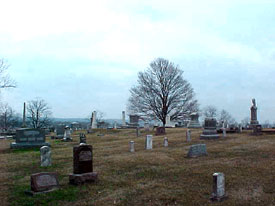Main Content
Article
Saving Historic Properties

Hicks Cemetery
Vermillion County, IN
So, you want to save a building, archaeological site, cemetery, or other historic site in your community? It takes the work of the local community, using resources at the local, state, and national level to protect these historic pieces.
Financial assistance can help jump start the porrect with needed money. If you are an individual who owns a property that will be income producing or a homeowner, look into the Investment Tax Credit Programs. DHPA also has grant programs, for which you may be eligible. There are also other governmental and private funding mechanisms to explore.
Various laws in Indiana help to protect historic sites. Knowing which laws pertains to your project will assist you as you work. Indiana’s archaeology laws and cemetery laws help protect these sites, while various state mandates and federal laws will assist with structures.
General Resources:
Advisory Council on Historic Preservation (ACHP) is the major policy advisor to the Government in the field of Historic Preservation. They also oversee the implementation of the Section 106 regulations. The Section 106 regulations (36 C.F.R. Part 800) can also be referenced on this website.
National Register of Historic Places through the National Park Service provides general information on the National Register program and a searchable database by state and county for a list of all resources listed in a particular county. For properties in Indiana we would also recommend checking the SHAARD database.
Building Rehabilitation Guidance:
The following resources are published by the National Park Service Technical Preservation Services office and provide both general guidance and more detailed information on specific treatments for the rehabilitation of historic properties.
The Secretary of the Interior Standards for the Treatment of Historic Properties with Guidelines for Preserving, Rehabilitating, Restoring and Reconstructing Historic Buildings (the Standards) are the main set of guidelines that are used to evaluate the appropriateness of work on historic properties. The Standards are used for Federal Reviews (Section 106), State Reviews, the Tax Credit Programs and the Historic Preservation Fund grant projects.
The Preservation Briefs provide technical assistance on various aspects of building rehabilitation as well as other related preservation topics, such as how to restore historic masonry and wood windows.
Additionally, the Preservation Tech Notes provide practical information on traditional practices and innovative techniques for successfully maintaining and preserving cultural resources. While some of the topics overlap with the Preservation Briefs, the Tech Notes include case studies of specific projects, often including photographs of before and after conditions with greater focus on specific treatments and implementation.
Potential Consulting Parties
The Indiana Historical Society provides information on the programs and services of the organization. The website also provides a list of local historical societies and county historians in Indiana sorted by county. Local historical societies and county historians can provide additional information on the history of a particular area. They may possess county histories and historical atlases, which are good resources for historical documentation.
Indiana Landmarks is Indiana’s statewide non-profit preservation organization. They have regional offices throughout the state, making their staff a great resource at the local/regional level. Additionally, they maintain a directory of preservation organizations within each county.
Federal & State Agencies
The following is a list of federal and state agencies that routinely participate in the Section 106 process. Please keep in mind this is by no means a comprehensive list of federal and state agencies that participate in the Section 106 and state review processes.
Federal Communications Commission
Federal Deposit Insurance Corporation
Federal Emergency Management Agency
Federal Highway Administration, Indiana Division
U.S. Department of Housing and Urban Development
U.S. Department of the Interior includes links to all its Bureaus: National Park Service, Fish and Wildlife Service, Indian Affairs, Land Management, Surface Mining, Minerals Management Service, U.S. Geological Survey, and Reclamation.
Indiana Department of Transportation Cultural Resources Office
Indiana Housing and Community Development Authority
Indiana Office of Community and Rural Affairs
Researching Historic Properties
In order to protect or preserve your cultural resource, you’ll need a number of tools to make it happen. Learning more about the history of your site or the context in which your property sits will help make a case for a National Register listing.
SHAARD: The State Historic Architect and Archaeological Research Database (SHAARD) and associated Indiana Historic Buildings, Bridges and Cemeteries Map (IHBBC) contain information on historic buildings, structures, and archaeology sites throughout Indiana.
Archaeology: If your project requires archaeology, as determined by our office, you will need to hire a qualified archaeologist to complete this aspect of the project. For more information on archaeology in the state, contact the State Archaeologist.
Cemeteries: State law mandates that before construction can happen within 100 feet of a cemetery (even those abandoned sites with no grave markers remaining), a Cemetery Development Plan must be completed through the DHPA. All known cemeteries are included in the SHAARD database and the IHBBC Map. If your project is within 100 feet of a cemetery, contact the Cemetery and Burial Ground Registry Coordinator.
INDOT Historic Bridges Inventory: The INDOT Cultural Resources Office maintains a survey of all historic bridges located on public roads in Indiana.
